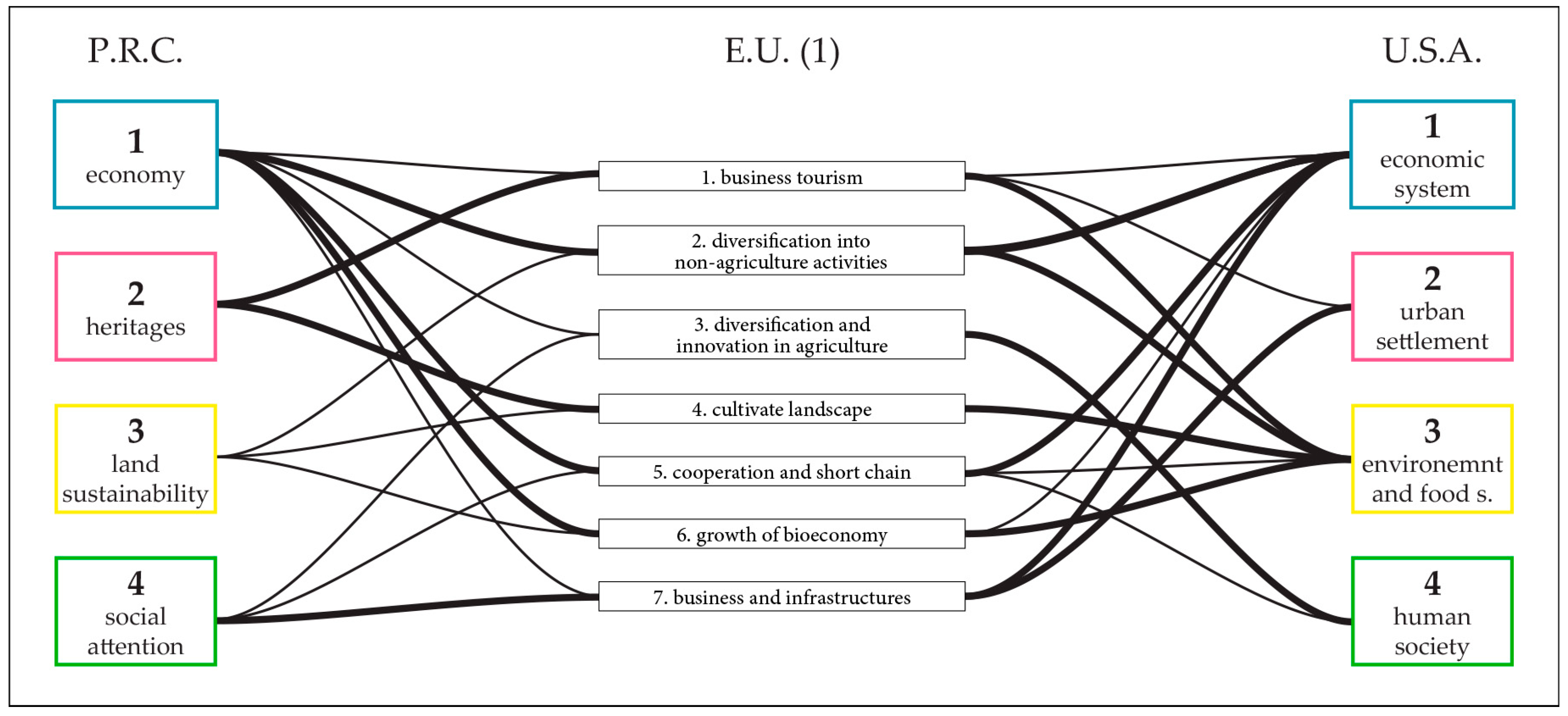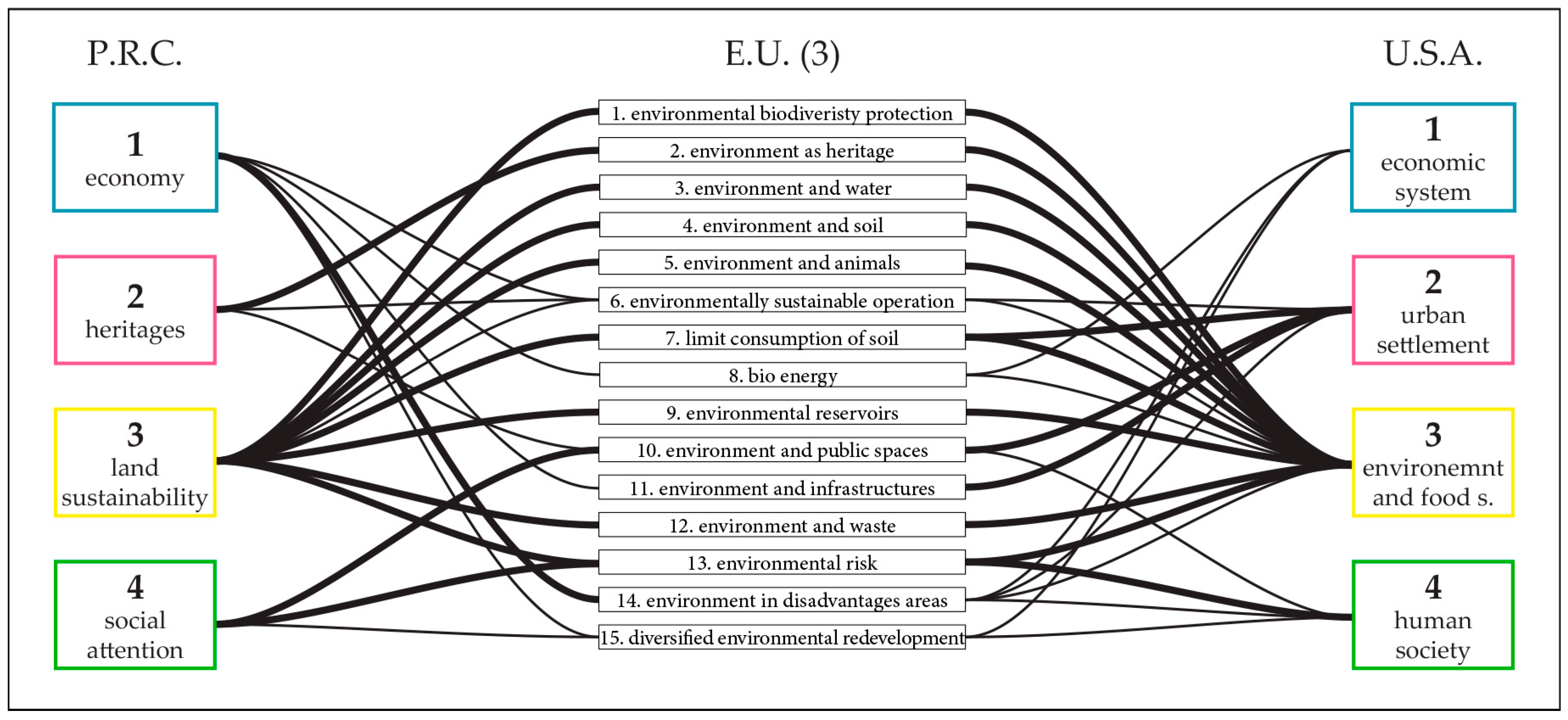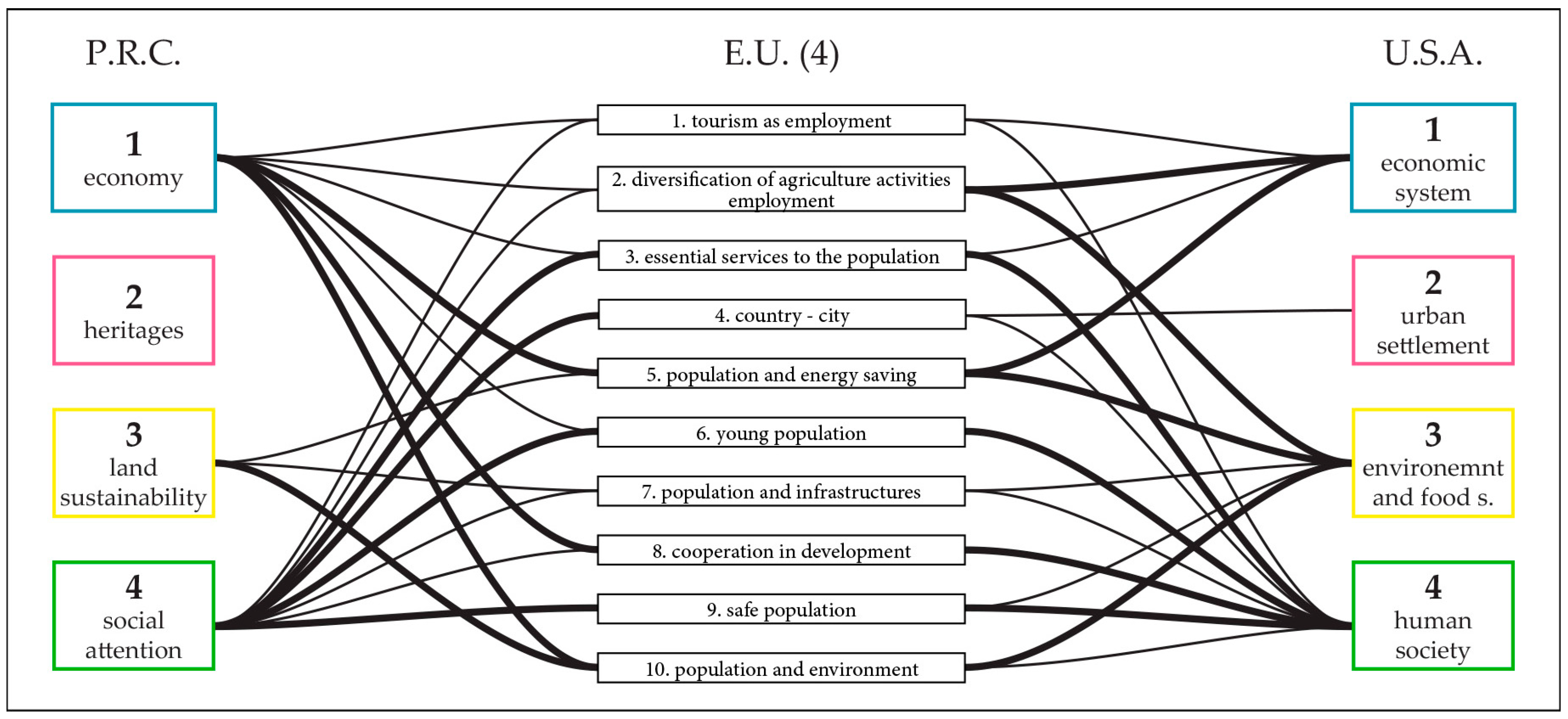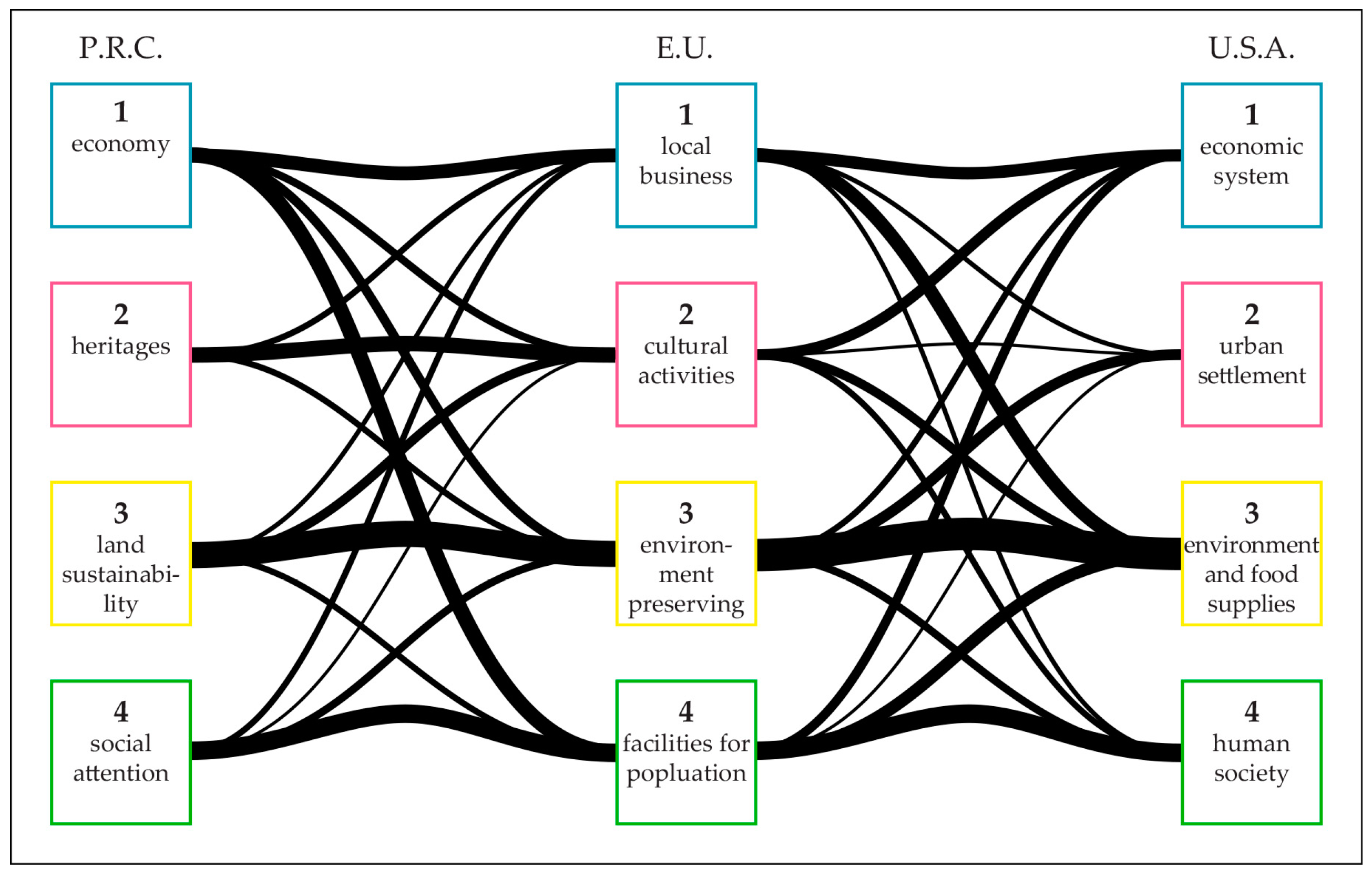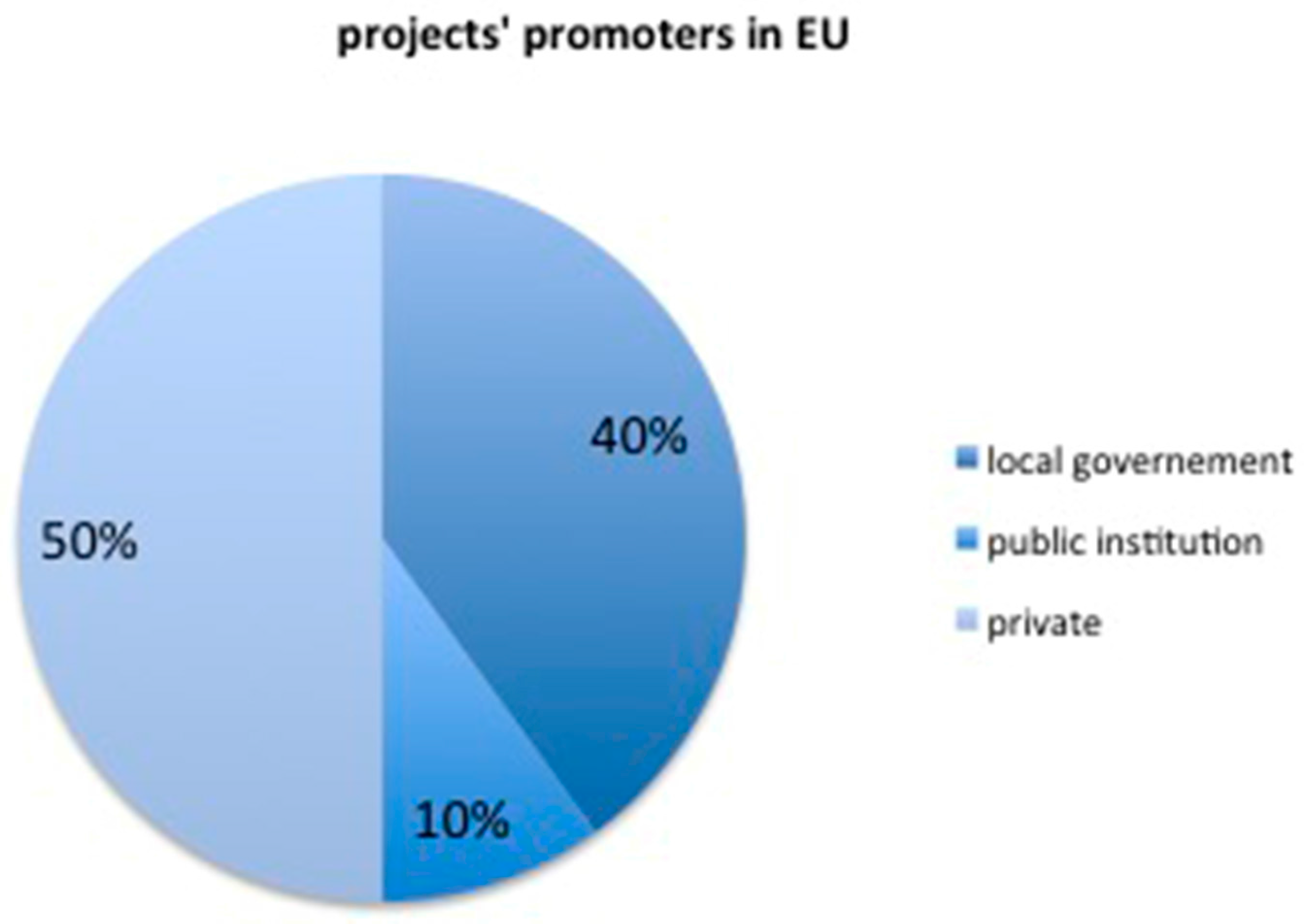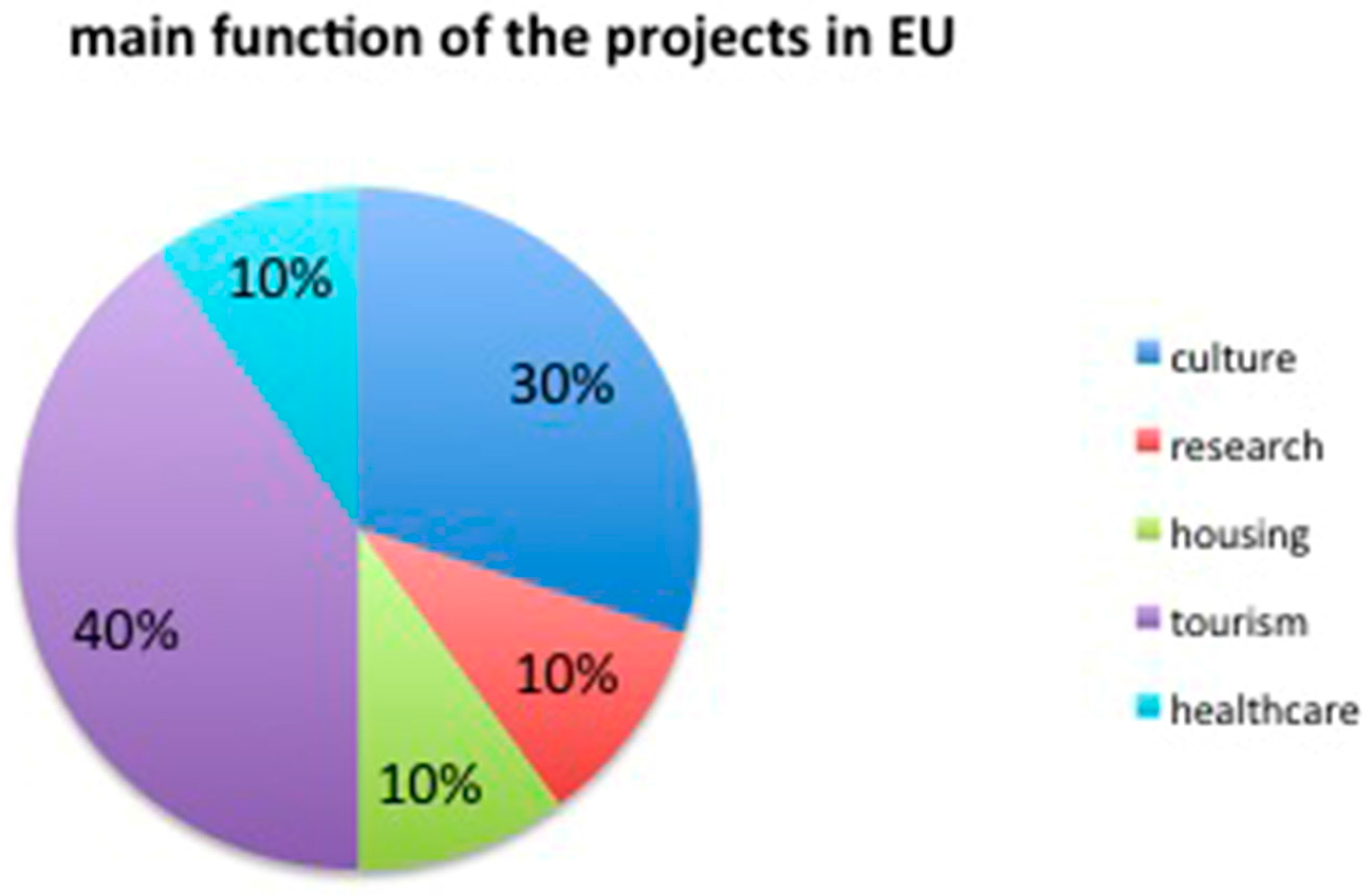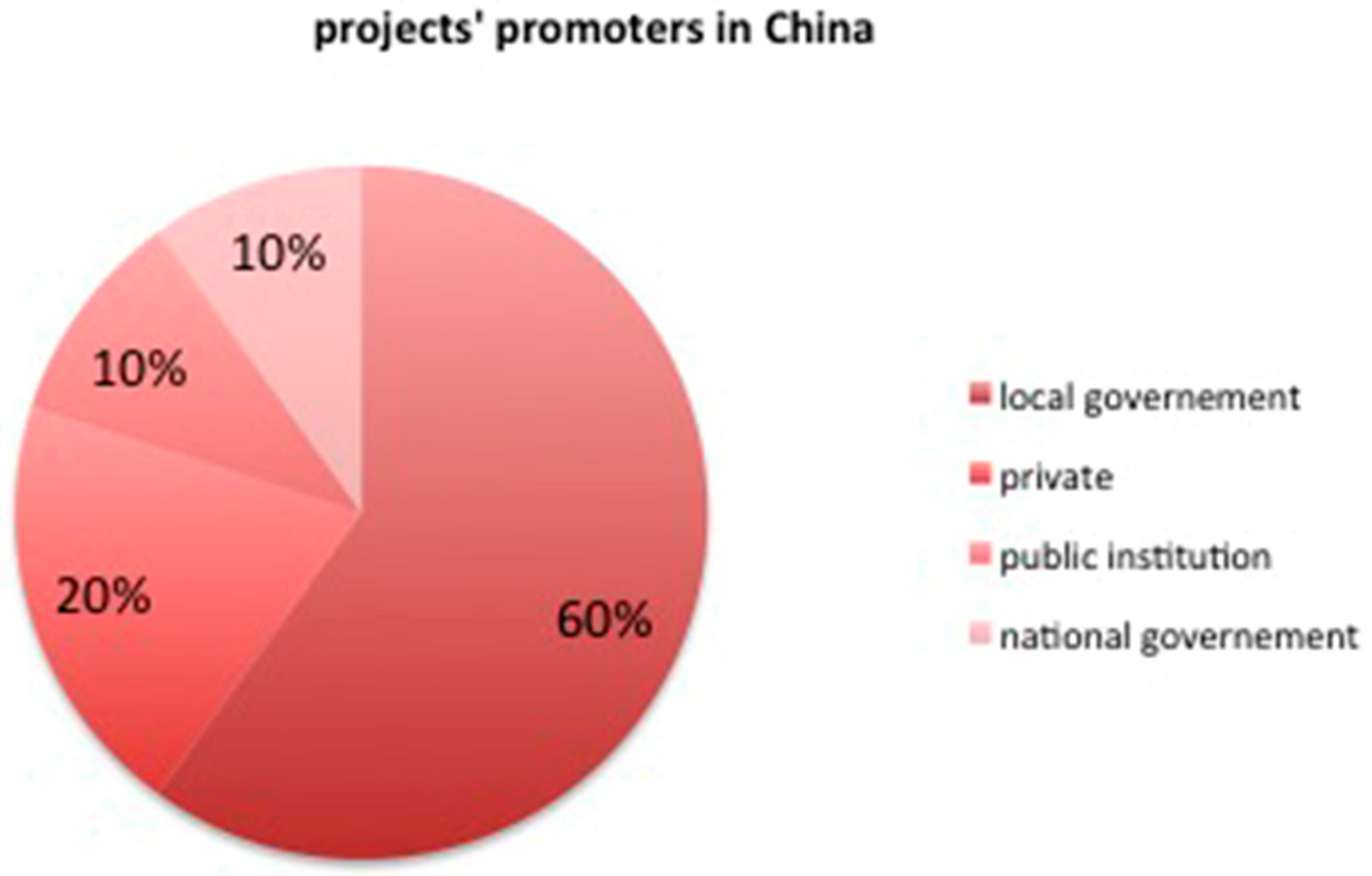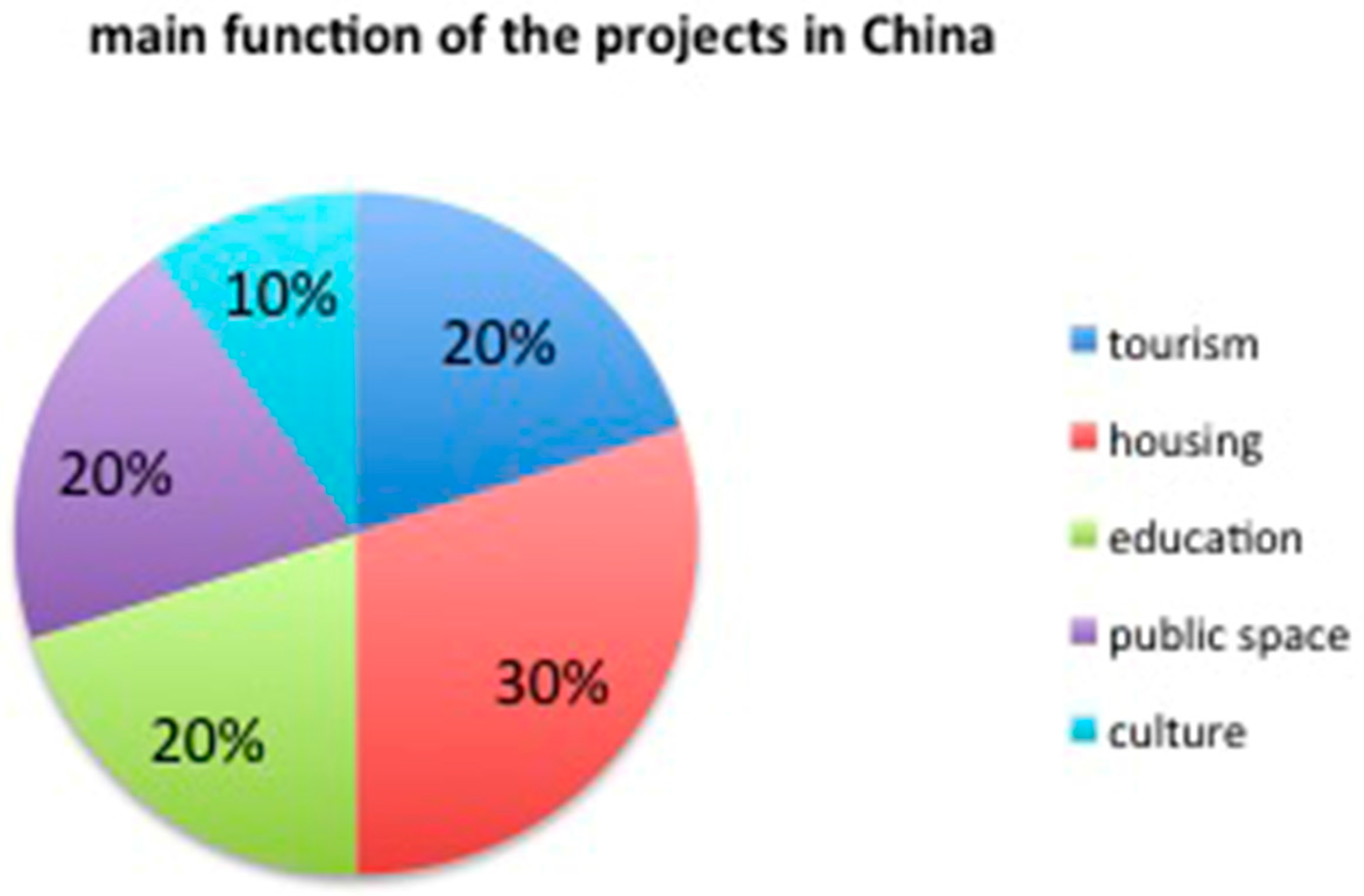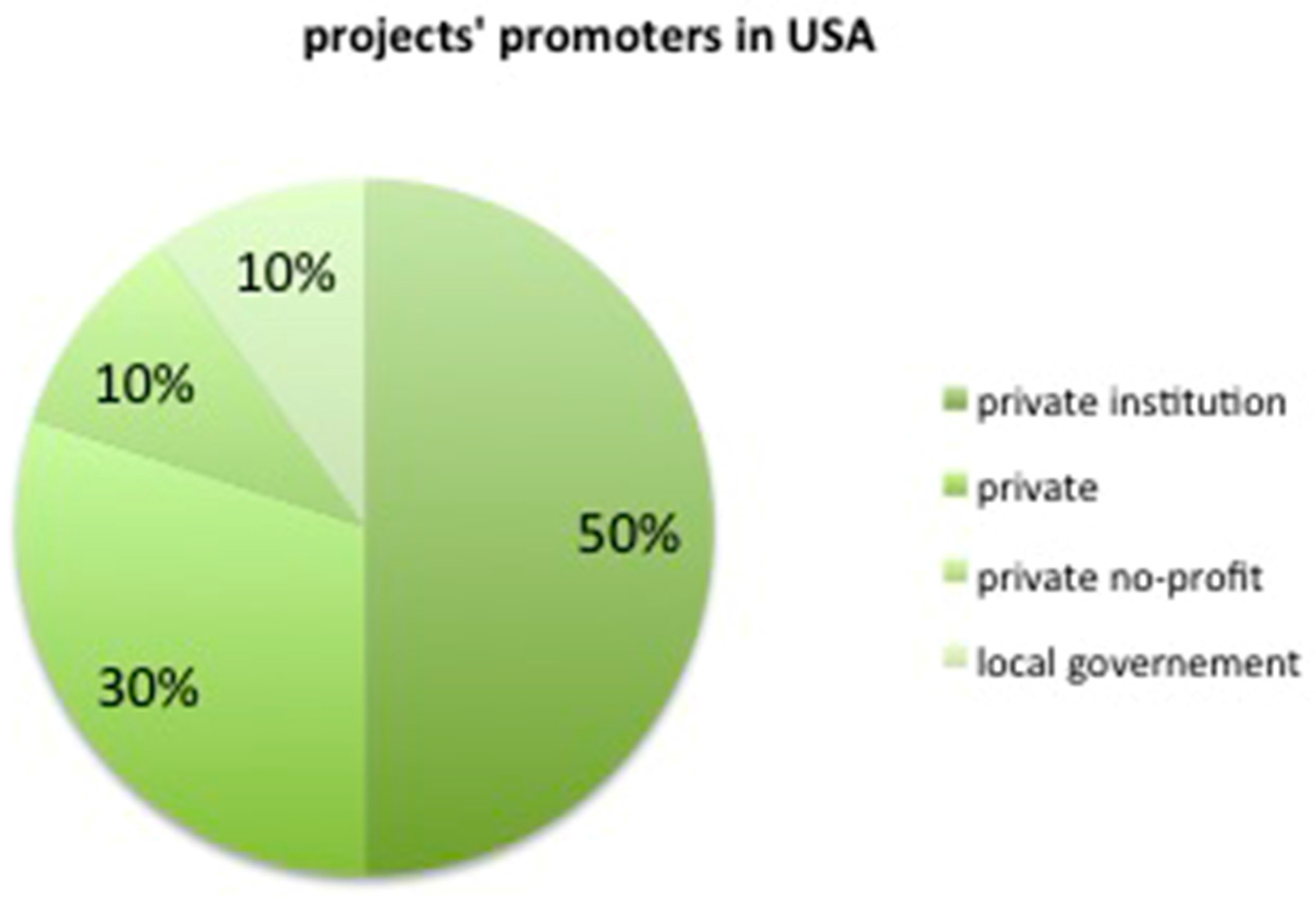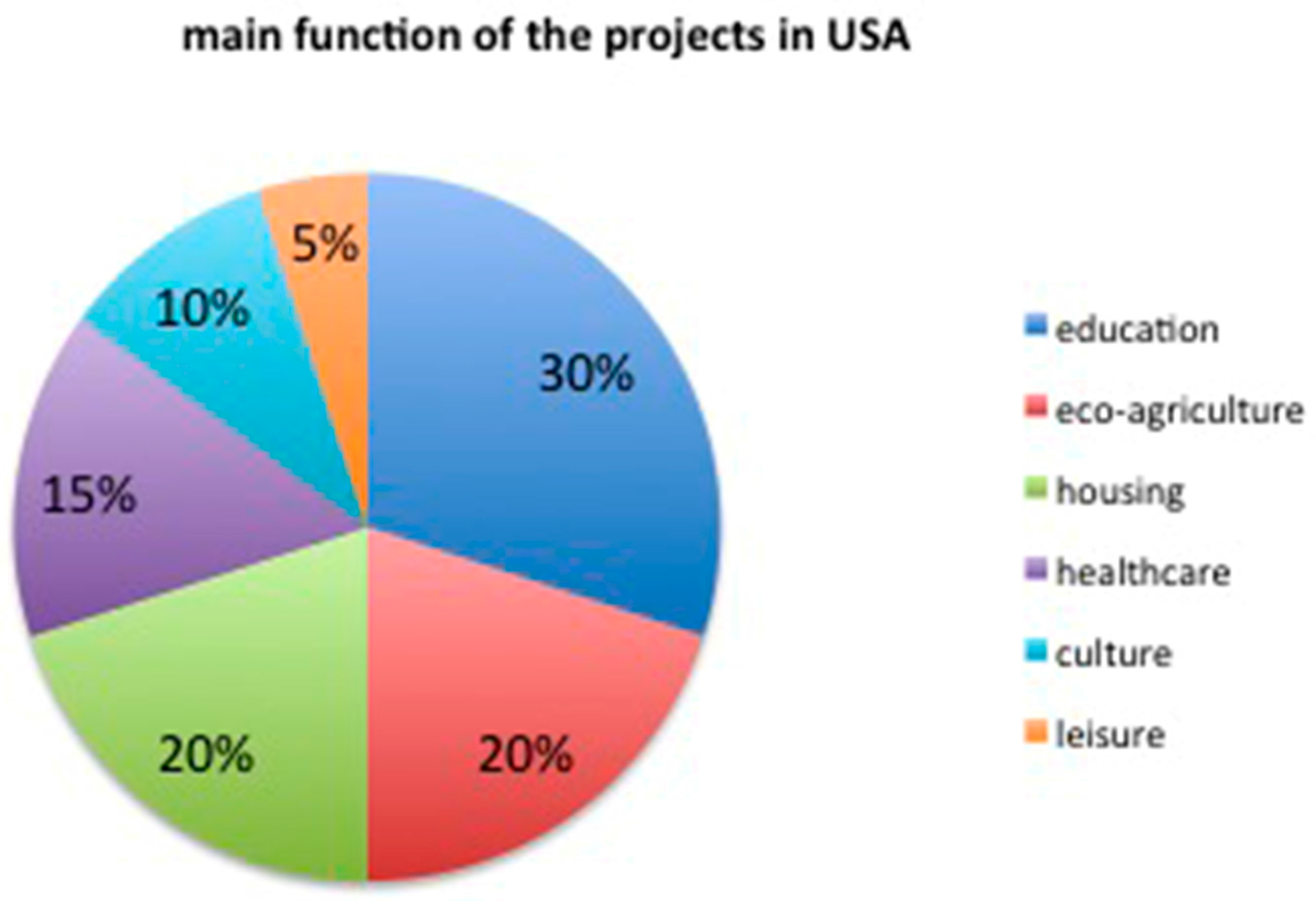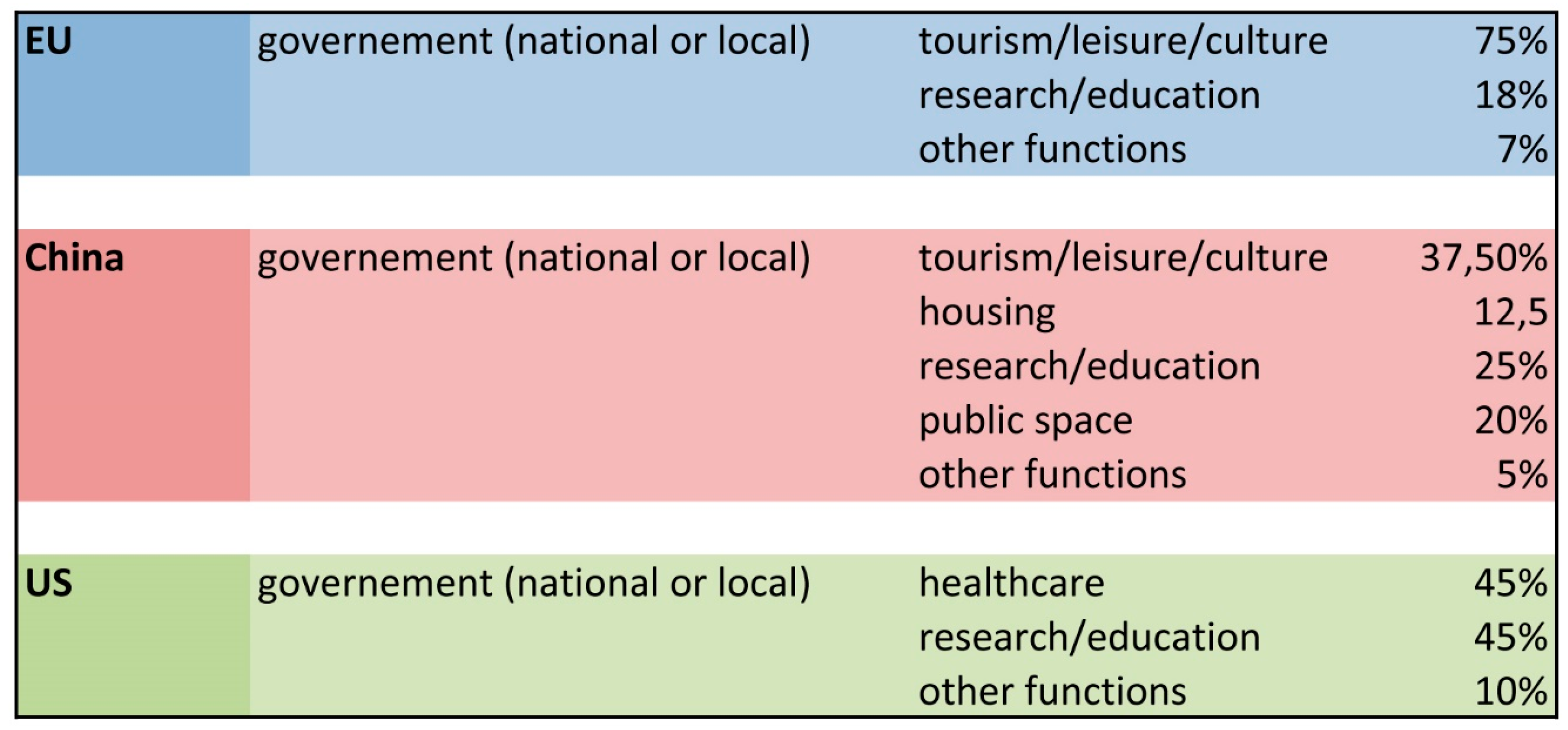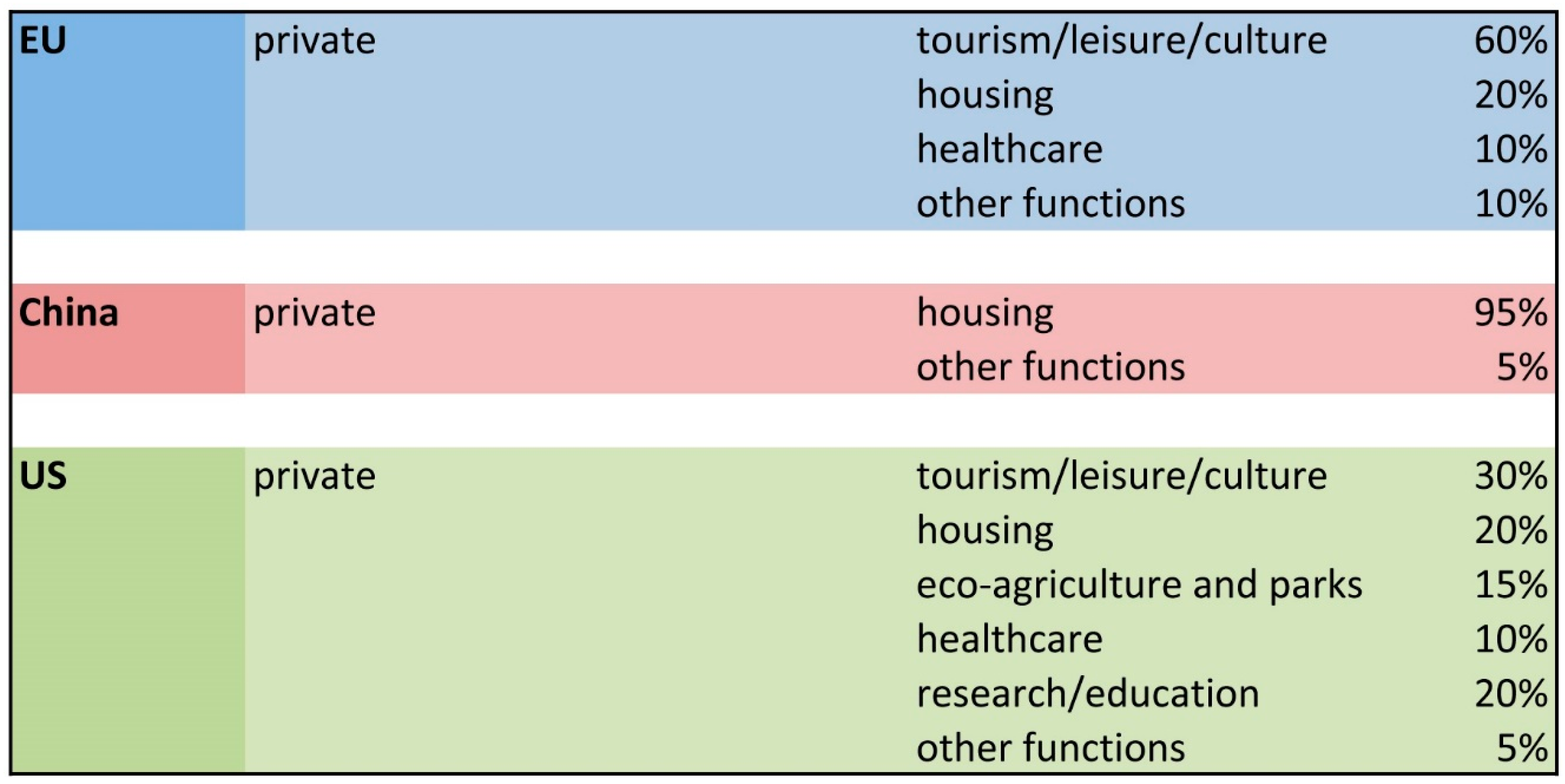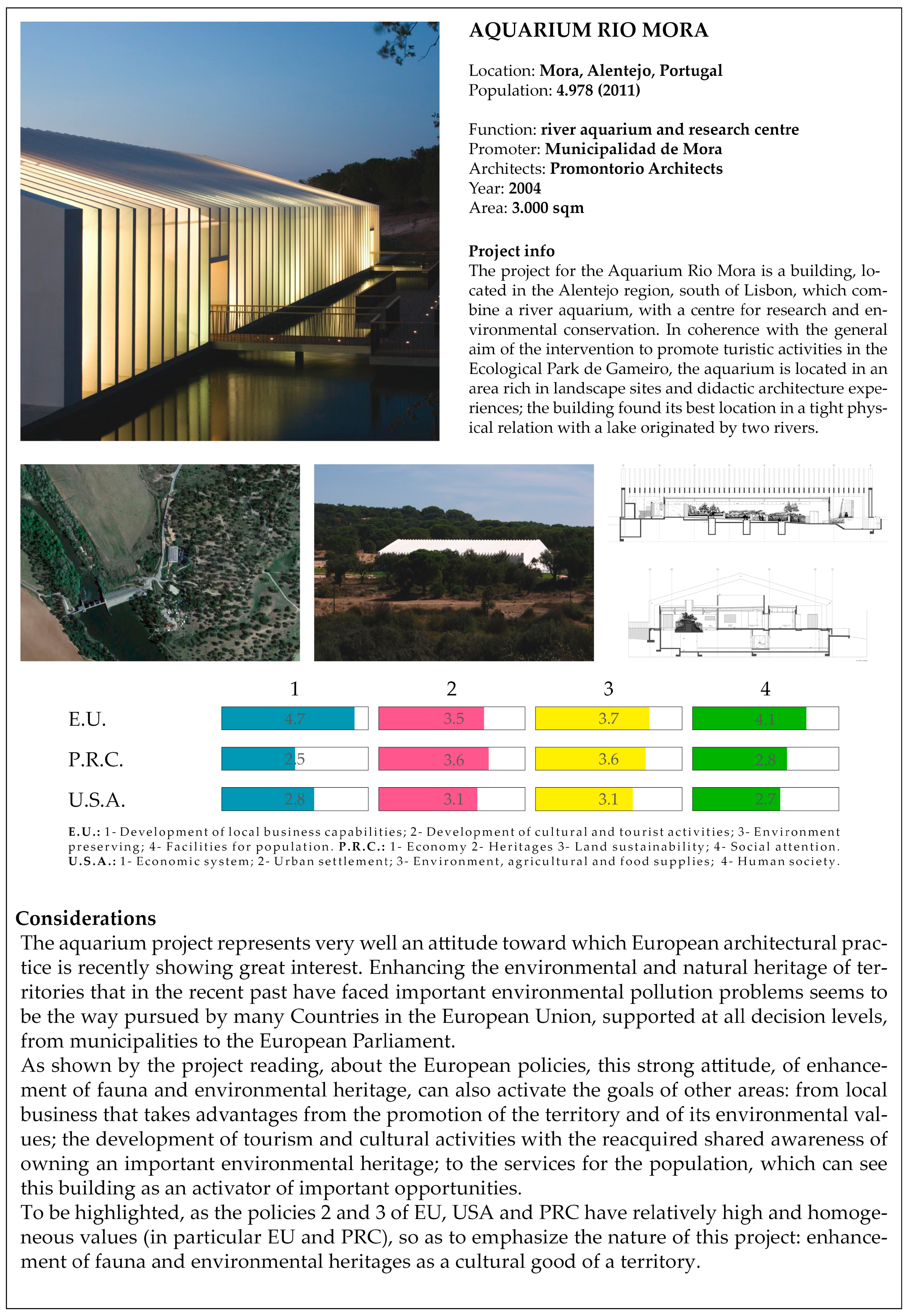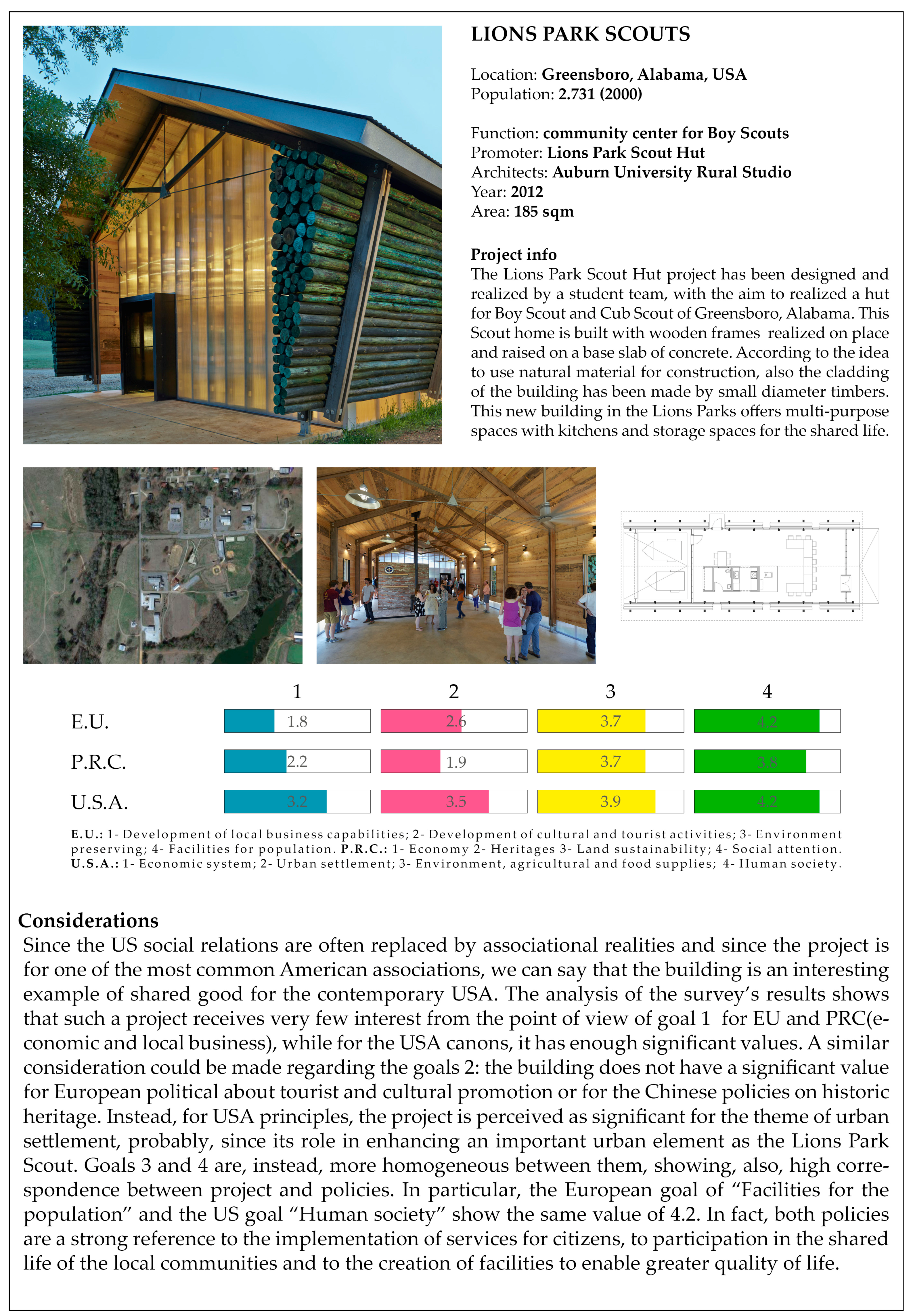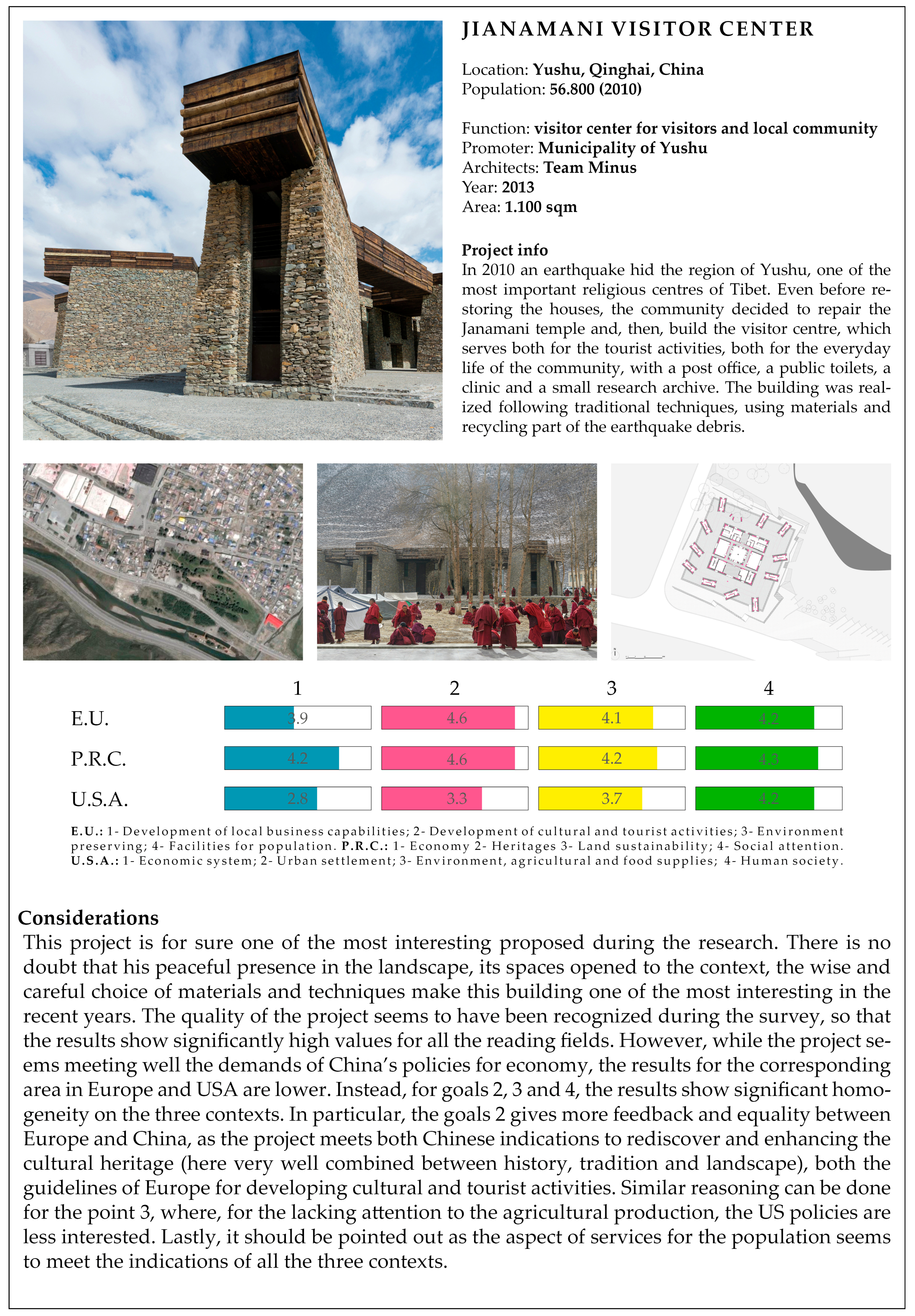1. Introduction
The study of coherences and differences between European Union (EU), United States (US) and People’s Republic of China (PRC) for rural urban development implies an interscalar and interdisciplinary analysis approach. Namely, a shift from the cause of urbanization is required: from urbanization intended as large cities growing to urbanization as minor rural-urban (and small cities) growing and connection.
This paper is built on the groundwork laid in previous research by the authors. In the first steps of the research a general Spatial Decision Support System has been defined with a specific application named Rural Architectural Intensification (RAI). In this context, the term Intensification introduces a new way of acting on rural urban context preserving existing buildings with a particular cultural (or architectural, historical, social, etc.) relevance and investing in new functions that may activate not only the mere built settlement but an entire territorial surrounding [
1,
2,
3,
4].
The previously defined global framework has a hybrid structure in which Spatial Decision Support Systems (SDSS) [
5,
6], Knowledge Discovery and Data Mining (KDD) [
7] and Expert Systems (ES) converge. Evaluation, Indexing and Spatial Analysis are the main themes and the proposed system uses different models and techniques: Multi-criteria Analysis (MCA) [
8,
9], Factor Analysis [
10], Cluster and Spatial Analysis [
11], Map Overlay, Anthological analysis, Best Practices database collection, semantic indexing.
The characteristics of the followed approach include Ecological Planning guidelines [
12,
13]; the applied method can also be read as a tool for Regional Spatial Planning define the key elements of complex region planning
Thus, the main goal is to implement the methodology applied in EU territory defined with Rural Architectural Intensification (RAI) and Rural Architectural Urbanism (RAU) to other contexts, in particular in China and US.
Despite the evident difference in economic, social and political conditions among countries, the same crisis’ impacts occur in rural regions. Therefore, this scale of investigation becomes a common ground where the urbanization causes a peculiar situation that is a semi-equilibrium neither urban nor rural.
So, USA is selected because of to the long tradition in rural-urban problems (from New Urbanism on), and PRC because it is one of the largest States in the world now facing the problem of how to distribute urban settlement respecting rural context and avoiding to increase the number of megacities.
In particular, bilateral relationships between China-EU and China-USA are one of the most strategic partnerships for development at both local and global level. Currently, the strength of the relationships among China, European Union and U.S.A. is unprecedented in comparison to their dealings in the past. Furthermore, it is imperative that all parties take steps to strengthen their relationship in order to jointly capitalize on opportunities and address the challenges of a rapidly changing world.
For example, guided by the annual EU-China summit both sides have extended relations through several Strategic Partnerships including the “China-EU 2020 Strategic Agenda for Cooperation” (adopted on 23 November 2013) and the “Joint Declaration on The EU-China Partnership on Urbanization” (signed in Brussels on 3 May 2012). As well as China-U.S. Collaboration on Rapid Urbanization gain great attention since 1991 and has been improved in November 2014 when both side made a renewed and expanded commitment to the U.S.-China Clean Energy Research Center (CERC), which include the expansion of funding for planning and building efficiency including the rural-urban issue.
2. Methodological Approach
In Rural Architectural Intensification (RAI) research, a series of projects (around 300) were indexed following some main and secondary strategic guidelines called pillars and sub-pillars: they derived from the analysis of official documents produced in recent years by the European Community for the rural-urban development.
For every selected project, a kind of driven data mining process is introduced; every intervention is finally tagged when it solves or faces one of the issues inserted in the list of pillars and sub-pillars.
Indexing the projects permits users (public bureaus, general stakeholders, professionals) to have a closer analysis of best practices that are particularly useful for the specific challenges they have to face within different moments and context (as a typical Decision Support System).
In particular authors define two main operative phases that represent a comprehensive process suitable for different contexts, needs and decision makers (from politics to administrative level, from planner to designer) [
2,
4]:
Where—What: there is a specific location in rural urban context, and decision makers (municipality, stakeholders, professionals, owners and so on) want to know which kind of function or intervention is suitable. The territorial interpretation addresses the choice of indexed projects that can be a guideline for designers to produce the final construction;
What—Where: there is a defined function (with specific dimension) that decision makers want to insert in rural urban context, and they look for the best location. In this case, the pillars and sub-pillars tagged in case studies must be used to find the specific area of territory that better present such characteristics.
Starting from the indexing based on EU pillars and sub-pillars, authors want to translate the indexing of the projects’ Data Base, based on EU vocabulary, into different lexicons derived from the analysis of official documents produced in recent years in US and PRC. To achieve this goal, the presented methodology follows these main steps:
- (1)
Selection of the main documents and directives that clarify the recent and fundamental approach in rural urban context;
- (2)
Definition of Pillars that can be considered as basic guidelines for future rural urban settlement;
- (3)
Description of the aim and the usability of such Pillars;
- (4)
Construction of relational matrix among Pillars of the different countries indicating the coherence and the differences among the different pillars;
- (5)
Definition of visualization techniques of relations’ system (throughout the EU sub-pillars), and measurement of the level of coherence between each couple of pillars;
- (6)
Selection of projects inside the Data Base (at least, one for each context);
- (7)
Tag on each project using the entire pillars list (one for each analyzed country).
All the methodological steps are described in detail in the next paragraphs.
3. Goals, Objectives and Criteria in EU, USA and PRC
From the study of the city-landscape through a historical overview of the evolution process of European territory and through the observation on current various urbanization situations, this research addresses the specific cultural and productive features in the European areas in which the phenomenon of rural intensification previously mentioned has reached significant impact.
Meanwhile in United States nearly 80% of Americans live in metropolitan areas, the suburbs around large cities have expanded, midsize cities and small towns have now grown into larger urban agglomerations and the rural population has declined (from 54.4% in 1910 to 19.3% in 2010). Changes to settlement patterns make complicated to define where an urban area ends or changes from the city center to suburbs and beyond.
Related to the urban growth, there is also a growing urban/rural discord: big cities often collaborate and work together more with urban counterparts across the globe than with the near rural areas and counties. The separation is widening in politics, funding, economic mobility and on social issues. Despite they are less than metropolitan area, the power of rural county is still significant: rural delegations tend to stick together and take advantages of separations that are common within metropolitan areas [
14].
In China the research project Rural Architectural Intensification (earlier mentioned) was selected to participate at the 2013 Bi-City Biennale of Urbanism\Architecture of Shenzhen and it was a good occasion to point out the experiences and ideas of EU rural development that could be adapted for the enhancement of Chinese rural-urban suburbs [
1].
It is well known that China’s urbanization is rapidly progressing: in 2014, the rate of urbanization was about 45% and in the next 20 years, the rate will reach approximately 65%, and by 2050, over 70% [
15]. This rapid urbanization is causing the construction of 2 billion square meters of building in China every year, improving the living standards of the Chinese people, but causing also huge environmental and resource pressures. Therefore, it is necessary to implement the principles of sustainable development. Nowadays, the theory of sustainable development has received general acceptance in China and the administration defined main principles of China’s ecological architecture design for rural-urban development. It is underlined that it is necessary significant resources preservation provide balance with nature, new rules and policies to protect the environment, reduce pollution, provide population healthy and define comfortable and efficient use of space.
The enhancement and development of rural areas and the minor urban settlements (villages and towns) are main components of landscape renewal along with the development of entrepreneurial activities (related to agricultural or not) that raise the quality of the environment (natural and anthropic) and its infrastructure system (and facilities). Therefore, in rural areas, the conditions of settlements and territory systems produce always links of interdependence the preservation and enhancement of minor urban settlements comes conceived in a more general framework of analysis, protection and regeneration of rural environment.
The study of main literature and national and federal laws of Europe, United States and China let authors to define the Strategic Objectives/Main Goals of Rural Intensification. The aim is to identify indicators and criteria that attempt to measure intensification’s outcomes which can be assessed in a qualitative way through the description and interpretation of operative tools for architecture and landscape design.
3.1. European Goals
The development of European cities and their fast-paced urbanization have created a perception of contemporary space as a homogenous continuum: city and territory have lost their original boundaries. Therefore, the rural landscape itself becomes a boundary and it represents the real contemporary city-landscape.
The crisis in rural areas is essentially a European problem: depopulation and ageing of population, abandonment and decay of small town centers, difficulty in keeping existing businesses, intensive agricultural practices that destroy biodiversity, pollution, lack of infrastructures and services for tourism, as well as a shortage of job opportunities for the population, etc.
The Strategic Goals, set out below for the development and enhancement of the European rural contexts, have been identified through the analysis of a wide range of literature and documents. In particular they come from the priorities issued for the rural development for the years 2007–2013 and the new framework recently published for the years 2014–2020 by European Community [
16,
17].
Authors present a short description for each Strategic Goal (Pillar) and the list of related Sub-Pillars: the goals represent the intensification of an activity or a plan set out for a certain territory, they also represent a metrics for the evaluation, indicators that attempt to “measure” intensification’s outcomes [
1].
3.1.1. Development of Local Business Capabilities (E.U. 1)
Agriculture stopped being the driving force of economic development for the countryside a long time ago now. For this reason, rural development policies have focused on strengthening jobs in non-agricultural areas: the creation of start-up companies linked to agriculture, which make the most out of a rural region’s potential could improve the population’s quality of life.
The entrepreneurial projects are usually small and medium-sized family-run enterprises in the processing and marketing sectors for agricultural products, livestock, local handicrafts, tourism, essential services, but also energy generation facilities from renewable resources and bio-economy activities: the importance of cooperation and short chain (from production to markets to end users) is clear.
In particular, the main topics are:
Business and tourism: encouraging the development of small businesses connected by a system logic to the cultural and touristic network of the area;
Diversification into non-agricultural activities: supporting farms in the process of diversification and expansion of activities, developing the production of non-agricultural goods;
Diversification and innovation in agriculture: supporting farms in the process of crop diversification and innovation in agricultural practices;
Cultivate the landscape: increasing the competitiveness of businesses by increasing resilience and the environmental value of natural ecosystems;
Cooperation and short chain: facilitating aggregation processes based on associative business forms to enable cost savings resulting from economies of scale;
Growth of the bio-economy: encouraging the development of the local economy by focusing on technological innovation and renewable energy sources;
Business and infrastructure: improving the competitiveness of businesses (also touristic), by improving the conditions of the infrastructure needed for development.
3.1.2. Development of Cultural and Tourist Activities (E.U. 2)
Among the European Countries, there are many small abandoned town centres, which are often the only evidence of a place’s history, its identity and unique features; they are a memory of events, characters, traditional agricultural economy and evolution that the countryside went through. They must be kept alive also with a strong diversification of activities compared with the original ones.
The region needs to be permanently inhabited, only then can it avoid falling into decline. One of the main activity that can ensure the improvement of a region’s attractiveness, also in less-favourable areas, is tourism: it is important to underline the link between tourism and architectural heritage, environment (water, woods, national parks, agricultural areas and so on) and the development of small-scale services and infrastructures.
The key points of tourism’s development are:
Tourism and architectural heritage: recognising new roles and functions for the architectural heritage, favouring the development of tourist and cultural activities;
Tourism and environment: recognising new roles and functions for the environmental heritage, favouring the development of tourist activities and cultural heritage;
Small-Scale tourism services: encouraging the infrastructure provided for tourist services with small-scale interventions;
Countryside vs sea and mountain: integrating rural tourism with traditional tourist areas (sea and mountains) developing the attraction capacity of the territory;
Tourism and water: promoting plural, diverse use of water resources also for tourist and recreational purposes;
Tourism and infrastructure: improving the competitiveness of businesses (also touristic), by improving the conditions of the infrastructure needed for development;
Tourism in less-favourable areas: encouraging sustainable tourism activities in less-favourable areas (mountains, rugged coast, etc.).
3.1.3. Environment Preserving (E.U. 3)
Biodiversity is disappearing: land is scarce even for farming; woodlands are being destroyed to make space for industrial expansions and the sprawl of cities and their ability to attract tourism through hospitality, rather than a strong immigration phenomenon, may also transform rural areas. The afforestation of agricultural land with permanent forests for environmental and tourism purposes is a good example of how to cultivate the countryside by converting wild or over-grown land, rather than the arboriculture of wood for the manufacture of stakes, biomass or paper. In addition, the modelling that the landscape has to go through is needed in order to reduce environmental risks and hydrogeological disasters.
Therefore, it is important to take into account the protection of environment and biodiversity (soil, water, animals etc.), the enhancement of the environment as heritage developing sustainable operations (related to urban space and infrastructures), diversifying the human activities, limiting its consumption to reduce natural risks and hazardous consequences. The development of environment preserving related policies must include the concepts of:
Environment and biodiversity protection: protecting the biodiversity of the environment, the growth of agro-livestock systems and high-value natural forest;
Environment as heritage: protecting the local natural environment as unique cultural heritage;
Environment and water: protecting the quality of surface and deep water resources, promoting water-savings and use for energy purposes;
Environment and soil: protecting the quality of soil resources by counteracting the phenomena of erosion, desertification of the countryside and over-use;
Environment and animals: protecting the native animal species, endangered species;
Environmentally sustainable operations: protect the natural environment by promoting sustainable building operations;
Limit consumption of the environment: in building expansions, limiting the consumption of natural resources (water, soil, vegetation);
Bioenergy: exploiting natural resources to reduce energy dependence from traditional fuels;
Environmental reservoirs: redeveloping and strengthening the natural reservoirs in the area and the main existing ecological corridors and connections between these different areas;
Environment and urban space: environmental protection of suburban space (also in the case of minor settlements, villages);
Environment and infrastructure: development, integration and environmental sustainability;
Environment and waste: waste disposal;
Environmental risk: preventing the hydrogeological instability of the land (landslides, mudslides, debris, flooding waterways);
Environment in disadvantaged areas: protection and promotion of sustainable farming practices in disadvantaged areas;
Diversified environmental redevelopment: ensuring multiple redevelopment areas within the same territory.
3.1.4. Facilities for population (E.U. 4)
The revitalisation of villages and rural areas through integrated initiatives including diversification, the creation of new productive activities (not only related to agriculture) and investment in the enhancing of cultural heritage (tourism) can form a development strategy for the directly involvement of local population (cooperation at any levels).
In order to create a better and safer place to live, also for young people, all the projects provide: farm nursery schools, primary schools, services for children and families, educational courses in food and environment, cultural activities for the dissemination of the cultural heritage and identity, clinics, first aid, hospices, veterinary clinics for farm animals, home help, mobility assistance for elderly and disabled people, sport centres, cycle paths, pubs and clubs.
Lastly, for the rural population, infrastructures are essential: any of them should be seen as a vehicle for regional intensification, even a tiny structure could be crucial for the accessibility and the social and economic recovery of a given location.
The main concepts can be summarized as below:
Population and employment, tourism: building and/or increasing the employment capacity in rural areas by improving the attractiveness of the territories;
Population and employment, diversification of agricultural activities: increasing employment capacity by a diversification of economic activities towards non-traditional agricultural goods and services;
Essential services to the population: improving the quality of life of the local population by encouraging the development/supply of essential services in the territory;
Country-city: improving the quality of life of urban population by planning the development of services that prefer non-urban locations;
Population, energy saving: promoting initiatives to support local economic development such as technological innovation and renewable energy sources;
Young population: improving the quality of life of young people and develop the attractiveness of the territory for future generations;
Population, infrastructure: improving the quality of life of the population by enhancing the condition of the infrastructure needed for development;
Cooperation in development: boosting inter-territorial and transnational cooperation to increase employment with considerable savings in economies of scale;
Safe population: improving public safety;
Population and environment: increasing the competitiveness of businesses by increasing resilience and environmental value of natural and agricultural ecosystems.
3.2. United States Goals
As the United States becomes more urbanized, rural–urban linkages become even more important and they are the basis for regional development managing urban sprawl and supporting local strategic land use policy that is economically, socially, and environmentally sustainable.
One important exchange between rural and urban areas is agriculture and food: i.e., national initiatives as “Know Your Farmer, Know Your Food” (KYF2) strengthen local and regional food systems and support the connection between farmers and consumers; “Farm to School Program” better connects schoolchildren to their food and to rural farmers.
Below, the most important issues related to rural–urban areas development and their enhancement are summarized (mostly from federal laws) [
18,
19,
20,
21].
3.2.1. Economic System
To strengthen the economic system of rural areas it is essential align federal policies, remove barriers to collaboration, increase the accountability and effectiveness of all levels of government to plan for future growth (smart energy and locally generated renewable energy). Moreover, it is important to enhance the economic competitiveness through reliable and timely access to employment centers, educational opportunities, services and other basic needs by workers, as well as expanded business access to local and national markets.
Enhance rural prosperity means also increase agricultural opportunities by creating new markets, and supporting a competitive agricultural system.
In the end, strengthen the local economy encouraging the development in traditional downtowns and town centers reducing community’s infrastructure costs by maximizing the use of existing systems is a key point for rural economic development.
The main issues related to the economic system are:
Agricultural and related activities;
Local economic competitiveness;
Village and town centers economically active;
Smart and green energy production.
3.2.2. Urban Settlement
To revitalize village and town centers is important to plan a strong functional mix use (residential, commercial, facilities) renewal reducing the amount of people that must drive to meet their daily needs and providing more safe, reliable, and economical transportation choices, working on the existing infrastructure (streets, water pipes, and sewer lines). Improving transportation options and bringing different land uses, such as houses, parks, medical facilities, offices, and stores closer together improve access to recreational facilities, health care facilities, and healthy foods reducing time, energy consumption and pollution. It is obvious that well-designed roads, sidewalks, buildings, public spaces, and other elements of the built environment support interaction among community members. In addition, preserving historic and cultural resources reusing buildings, especially those with historic value, contributes to a community’s distinctive identity, which can attract tourists and new residents.
Moreover, new federal policies are necessary to promote equitable, affordable housing especially energy-efficient housing choices for people of all ages, incomes, races, and ethnicities.
The key points are:
Green infrastructure;
Affordable greenhouses;
Village and town-centers;
Strong functional mix use in all the towns;
Public spaces;
Historical and cultural heritage.
3.2.3. Environment, Agricultural and Food Supplies
All the policies underline how it is essential to preserve, restore and made more resilient to climate change the national forests and the private working lands, in order to enhance park systems and the development of natural, sports and eco-tourism (15% of the country’s total land area are highly protected and an additional 18% are protected from conversion but extractive uses are allowed). State, local, and national park systems and regional preservation organizations play a vital role in managing rural-urban linkages by facilitate the movement of people between urban and rural spaces, encourage interaction among different communities, creating places for rural and urban residents to enjoy sustainable recreation and support natural resource management. In particular: improving the health of the Nation’s forests, grasslands and working lands by managing natural resources; leading efforts to mitigate and adapt to climate change, drought, and extreme weather in agriculture and forestry; contributing to clean water by protecting and enhancing water resources and reduce risk of catastrophic wildfire.
Moreover, it is important to help rural communities to protect natural habitats and ecosystems, the waterways, forests, mountains, view sheds, and farmlands that are critical to their economic health, especially in places valued for their scenic or recreational assets. Also providing incentives to use green infrastructure and preserve open space, along with programs to educate residents on the importance of land conservation, helps communities to preserve natural resources.
Another key point in environment and human health preservation is related to the agricultural resource and system: enhancing global food security; protection of agricultural health by minimizing major diseases and pests; ensuring access to safe, plentiful, and nutritious food; enhancement of the ability to develop and trade agricultural products derived from new technologies; ensuring access to safe, nutritious, and balanced meals for all children.
Lastly, it is important to support and improve more compact development patterns and small-scale agriculture and gardening in neighborhoods to improve quality of life, especially in more rural areas where larger grocery stores are often only accessible by cars.
The reference key concepts of these policies are:
National forest;
Eco-tourism;
Nature and sports;
Environment and water;
Environment and soil;
Natural habitat and biodiversity;
Avoid soil consumption;
Green energy production;
Agricultural activities;
Small-scale agricultural and related activities;
Healthy food production and distribution;
Balanced meals for schoolchildren;
Information and communication of healthier life style.
3.2.4. Human Society
In a really huge, widespread and isolated territory, it is essential to assist rural communities to create prosperity, self-sustaining, re-populating, economically thriving, to increase their revitalization, the efficiency of public works investments, and safeguard rural landscapes. Moreover, enhancing the unique characteristics of all communities by investing in healthy, safe, and walkable neighborhoods (at rural, urban, or suburban level) especially in relation to road safety, social housing and the promotion of healthy diet and physical activity behaviors to help people to live more active lives and to support better health.
Lastly, it is important the creation and implementation of new communications tools, cultural events, and the participation in local government issues that can create a sense of belonging to community. To summarize, the key points are:
Implementation of essential services;
Development of social and community participation;
Enhancement of communities identity and peculiarities;
Improve the local population’s quality of life;
Creation of safer, greener and healthier neighborhoods.
3.3. Chinese Goals
For PRC, the last decade has been a period of deep changes that continue. The phenomenon of migration from rural areas to the cities and the resulting rapid urbanization are, on one hand, the symptoms of major changes in society and production system, on the other hand, they are the cause of many other disruptions taking place in China that affects both rural areas as urban areas. In particular, the changes at the base of the economic system, the modernization of agriculture, with the consequent rise in unemployment in rural areas and in towns, the spread aspiration to city lifestyles have caused a sharp movement to the cities.
Therefore, the rural areas are becoming emptier, aging and need special attention in terms of economic activities and services offered to the population. Moreover, in these areas the abandoned built environment undergoes rapid phenomena of degradation with the consequent risk of damaging for the architectural and cultural heritages.
At the same time, cities have to plan the reception of these great migratory flows and the answers led often to problems of environmental sustainability and preservation of common goods, intended as territorial and cultural heritage. In particular, it should be noted, as in the cases of towns and cities, the design of new districts has some gaps in the steps between the scales of the downtowns and the new developments, so that the major residential projects have become elements, isolated and independent from the existing urban context.
Balancing the licit race for economic growth with the control of these phenomena is one of the main goals that the Chinese government has self-imposed. Therefore, the policies promoted by the central government and the Administrations, for the management of changes and for the protection of the environment (social, natural and cultural), are definitely of strong scope and defined by specific policy plans. Among these plans, the research took into account the “New Urbanization Plan for 2014–2020”, presented in March 2014 by China’s government and the “Chinese 13th Five-year Plan” (2016–2020) [
15,
22,
23].
According to the anthological analysis of the documents, it is possible to understand that the efforts of plans are directed towards the following directions.
3.3.1. Economy
The role of economy in developing opportunities of enhancement of rural and urban lifestyles is considered fundamental, the more considering the rapid and heavy changings occurring in this wide country as China, whose economy crossed some decades of total transformation. Agriculture, the driving force of China's economy until a few decades ago, has undergone a major mechanization phenomena and its role in the Chinese economy has been displaced in many areas of the Country by the industrial and innovation sectors, whose incredible developments have led China to be among the world leaders in these fields. These upheavals have forced that the issue of the economy fell into policies for the rural urban, promoted by the government. Affecting, in particular, these concepts:
Give strong impetus to a sustainable and green growth;
Clean production to be promoted and green low-carbon industry systems setup;
Restructure the industry processes making it balanced, green, and IT-directed; and
Promote agriculture modernization and support new-style professional farmers.
3.3.2. Heritages
The historical and cultural heritage values are among the elements that are attracting the greatest attention from those countries, including China, whose economy is going towards a post-industrial knowledge-based model. However, the importance of cultural heritage plays a significant role in promoting identity and cultural diversity, enhancing the sense of community and belonging, in other words, to improve the quality of life. The promotion of cultural heritage policies (referred to artistic, architectural, urban, landscape and natural goods) takes place both in urban and rural areas.
In rural areas, they want to re-release the potentiality of abandoned buildings and villages, making them items for the economic promotion, for the defense and control of territory and for the social cohesion. In urban areas, they want to promote a new focus on the planning and design of new interventions, directed in particular towards the historical centers and the existing, making it possible to offer better employment opportunities, services, shared and urban spaces. The concepts expressed by government policies can be summarized as:
Attention to the landscape quality;
Enhancement of the urban tissue and the historical goods;
Improve the distinctive characteristic of each city;
Promote opportunity for hospitality and tourism; and
Take initiatives to support the creative and cultural industry.
3.3.3. Land Sustainability
A Country like China, that has spanned decades of consumption of natural and territorial resources, cannot but think a future development structured in an environmentally sustainable manner. Issues such as air and water pollution and the protection of the territory are key topics: from the forest areas, to the agricultural and coastal ones. The protection of land and environment means, in the medium and long term, a better quality of life for people but also preservation of the Chinese rich biodiversity and of the variety of environmental richness, considered an unlosable natural heritage. Designing a sustainable development requires great economic organizational and the planning efforts, and it is definitely one of the pillars which the development program of China in the coming years is based upon. The key concepts are:
Promotion of the land sustainability, forest protection, limit deforestation;
Protection of biodiversity;
Boosting of agricultural production;
Safeguard of system of water resources and air quality;
Attention to the design of urban layout at all the scales;
Participation of communities in reconstruction;
Legal land use rights of farmers to be ensured.
3.3.4. Social Attention
The composition of population in rural areas is becoming more and more uncertain. Chinese policies are promoting the possibility to offer all people the same opportunities. Regaining the lost attractiveness of rural areas is one of the most important topic, in order to balance the presence of social and economic opportunities. The reference key concepts of these policies are:
Aging;
Inoccupation;
Balance regional and rural–urban development;
Improvement of livelihood;
Communitarian belonging;
Deepening reform of the household registration system.
4. Criteria Comparison
The analyzed contexts, very different in the field of law and policies, cultural background, population needs and main development objectives, have produced a significant number of Main Strategic Goals.
In order to define the similarities and the external coherence among EU, US and PRC goals, authors make an evaluation of their interaction by making a comparison of the sub pillar of each main European goals with the different US and PRC Strategic Goals. By assigning a numerical value from 0 to 1 to the interaction among elements (where: 0 means no interaction, 0.5 weak interaction and 1 strong interaction), authors define the most significant Strategic Goals and moreover the effectiveness of each of them in different contexts, that can be relatively different from those for which they had been set. For example, the idea of tourism is completely diverse: while in Europe, there is “tourism” in almost all the goals directly or un-directly, in China it is more limited or not adequately emphasized in policies and in the United States the concept refers primarily to natural element or to great modern metropolis.
The output comparison underlines and shows a complete overview of the usability of each Strategic Goal in different contexts: it validates both the pillars (setup for a particular territory but suitable for different areas with fewer adjustments) and the methodology presented.
Above, the logical connections’ diagrams show the relationships among European sub-pillars (a diagram for each European pillar) and Chinese and American Strategic Goals.
The first image below (
Figure 1) shows as the interactions with the European Goal “Development of local business capability” are homogenous among all the US and PRC pillars with a highest concentration in the US “Economic System” and in the PRC “Economy”. They do not seem to affect significantly the PRC “Land Sustainability” (3 links but each with a value of 0.5) and the US “Urban Settlements” and “Human Society”.
Figure 2 shows the interactions with the European Goal “Development cultural and tourism activities”: while it is very strong the links with the PRC “Heritages” (4) and “Economy”, the US connections are more diffuse. The highest score is on “Economic system” (3.5) followed by “Environment, agricultural and food supplies” (3): in the US context the strongest idea of tourism is related to the natural environment rather than to heritages or ancient urban settlements and, obviously, tourism activities are driving forces for local economy.
In
Figure 3 there are the interactions with the European Goal “Environmental preserving”: the strongest links are with the PRC “Land sustainability” (8.5) and the US “Environment, agricultural and food supplies” (10.5). Moreover, the US Goal “Urban settlements” takes a 3.5 evaluation score because of its environmental issues related to the expressed needs to improve green infrastructures and affordable greenhouses. The PRC Goals “Economy” takes a 3 evaluation score in relation to the policies to enhance green low-carbon industry and a sustainable growth.
Figure 4 shows the interaction with the European Goal “Facilities for population”: the links are particularly strong with PRC “Economy” (5) and “Social attention” (6) but completely absents with PRC “Heritages” because the attention is focused on physical elements of settlements and the economy that not directly affected the life of population itself. The US “Human society” takes a 6 evaluation score followed by “Environment, agricultural and food supplies” because of the policies about the enhancement of the production and distribution of healthy food and balanced meals for school children and about the development of stronger information system and communication tool of healthier life style.
5. Results of Policies Assessment
The image above (
Figure 5) shows clearly how strong is the interaction among all the European American and Chinese policies related to the environment, the protection of natural resources and the idea of sustainability (and its various meanings so closely connected to economy and society).
Moreover, the economic aspect presents similar connections: there are close ties especially between Europe and China (see also
Figure 6) because the first one has policies in the economic and human aspects that are strictly connected to the economic policies in China.
There is not a link between the European pillar “Facilities for population" and the Chinese Strategic Goal “Heritages”: in China few policies underline the importance of tourism and architectural and historical assets as driving forces to improve the population quality of life and its participation in the decision process.
It is interesting to underline for Sustainability and Environment issues there is a very strong coherence among the different international goals, even if they are defined in quite different ways. This is a good result considering that from decades the issue is worldwide well known but in many situations (i.e., during Kyoto Protocol discussions) both US and PRC where not aligned to EU proposals.
6. Projects
This phase of policies’ application to the case studies began with the projects’ choice. The research took into account a total of thirty case studies (10 per analyzed area) realized in three different areas of the studied policies and considered by the contemporary debate (magazines and scientific papers) as best practices (
Table 1,
Table 2 and
Table 3).
In EU (
Figure 7 and
Figure 8), in rural areas, private developers promote 50% of the projects while public sector (local government and public institutions such as universities, research centers, and so on) promotes the remaining 50%. Tourism and culture are the main functions and the main core of investment with 70% of the projects.
In China (
Figure 9 and
Figure 10) Government (local, national, or public institutions) promotes the 90% of the projects for the development of rural areas. Housing together with education and public spaces represents 60% of the projects. Tourism and culture are 30% only. This is an opposite situation compared to the EU.
In the USA (
Figure 11 and
Figure 12) is completely the opposite of China regarding the promoters: 90% of the investments for rural development projects are private, the government promotes only the 10%. Here, the functions are equally distributed between tourism, education, eco-agriculture, healthcare, and culture.
The choice of projects depends by several factors. First, they are projects that have received, from their realization to the present, considerable interest from the scientific and professional community for the reasons that follow. In fact, they are seen as practices that best represent the themes that the contemporary debate faces about the problems of social and environmental sustainability, the abandonment of rural areas and the phenomena of rapid urbanization. Features such as intervention’s scale, functions, promoters, context, costs or catchment area were not considered a discriminating in the choice of projects. These attributes represent only the various characteristics that the projects, that the research aims to analyze, may have. In fact, the research wants to propose a reading and a comparison among guidelines and policies designed for the design in the rural-urban contexts of Europe, of the United States of America and of the People's Republic of China. Therefore, there are two main characteristics shared by the selected case studies, which represent the discriminating choices besides being universally considered as best practices: they address the issue of rural-urban and show high aptitude towards social and communitarian issues.
In fact, the chosen projects focus on giving answers to various social problems that may vary, depending on the context, from the attention for the forms of associations, to promote tourism and communitarian identity, to enhance the environment as a form of cultural heritage. As already mentioned in the description of the three contexts and in the definition of policies, the component of participation in community life is an ever-present element. Effectively, it acts hindering the phenomena of the abandonment and social and environmental degradation, promoting new forms of sociality and economy, enhancing vitality and a better quality of life levels.
In order to broaden the significance of these data and achieve meaningful understandings it is possible to read in different way these value; for example, by connecting project’s promoters (private, local/national government) with the main function of the projects (housing, culture etc.) and aggregating categories as tourism/leisure/culture, or research/education and so on.
From the
Figure 13 come to light that in EU 75% of actions promoted by governments of are concentrated on the tourism/leisure/culture functions thanks to two main factors: the quality of the European landscape and the more incoming and effective business guaranteed by the sector of tourism industry. Moreover, is interesting to note that the research/education sector in EU is growing up at 18% of projects analyzed. This data is depending by the fact that more European regional governments are investing in high-tech campuses or universities campuses located in rural areas imitating, sometimes, the US campuses model of educational institution or technologies industry such as, i.e., Google campus, Facebook campus etc.
In China, in recent years, the central government is also promoting and investing in the tourism industry, which is playing a more significant role in China’s economy. However, huge percentages of investments are oriented to research/education sector together with the regeneration of public space. This result is coherent with the new trend sponsored by local Chinese governments that intend to adopt an inclusive approach and collaborative actions for transparent activism and public operation with the aim to generate an integrated public life. Regarding US government promoters, the major investments are target oriented to a sort of traditional sectors as healthcare and research/education.
Figure 14 presents the same analysis for the private promoters. Comparing the three countries emerges that the housing sectors linked to the real estate’s market gain the main attention of the operators attracted by the high incoming. Though this result could be obvious it provides a meaningful insight especially referring to the China context. In China 95% of the investment are oriented to the construction of new houses in rural areas provoking the phenomenon of speculation, high rate of land use and pollution among many other, which generate negative impact in terms of sustainability. The task facing China is immense and policymakers, designers, citizens and stakeholders should have clear to turn direction and pursuit new target of sustainability from now to the near future.
In brief, the results of this analysis (
Figure 13 and
Figure 14) confirm the validity of the diagrams presented earlier at
Section 4 and
Section 5 and provide an insightful check list useful for designers, policymakers, citizens and stakeholders on which strategies should be pursuit in the future for a sustainable rural development. Moreover, this model of investigation could be implemented with the aim to pass from analytical phase to the predictive tool for future projects instead of as a post-evaluation on realized projects.
6.1. Application of Goals/Policies to Case Studies, Their Reading, and Comparison
After selecting the thirty projects and, for each one, enough and homogeneous material to have an overall picture of the project have been prepared. These documents were given to a sample of volunteers from the course of Building Engineering and Architecture of the University of Pavia (Italy) composed by 65 students from Italy, European countries (in Italy within the Erasmus Programme) and China (enrolled at the University of Pavia within the Double Master Degree in Building Engineering and Architecture, according to the Agreement between University of Pavia and the Tongji University in Shanghai), in order that they would provide their personal reading of the projects. In particular, it has asked the volunteers to give their opinion on the correspondence between the goals of the policies and the projects, assigning values on a scale from 1 to 5 (where: 1 = strongly disagree, 2 = disagree, 3 = neither disagree nor disagree; 4 = agree, 5 = strongly agree). So, the obtained results were processed to provide an average value, approximated to the decimal place.
6.2. The Presented Cases
Specifically, for obvious needs for space and for presentation opportunities, this paper presents only three of the thirty cases studies, proposing one for each area. Following the data synthetized in
Figure 7,
Figure 8,
Figure 9,
Figure 10,
Figure 11,
Figure 12,
Figure 13 and
Figure 14 about promoters and main functions, among all the projects, authors select these three:
Aquarium Rio Mora, Promontorio Architects, 2004, Mora, Portugal (Europe) [
24,
25,
26] (
Figure 15);
Lions Park Scout, Auburn University Rural Studio, 2012, Greensboro, AL (U.S.A.) [
27,
28] (
Figure 16);
Jianamani Visitor Center, Team Minus, 2013, Yushu, Qinghai (China P.R.) [
29,
30,
31] (
Figure 17).
The sheet of each project offers:
Pictures of project and surroundings and a drawing (plan or section) that best represents the project idea and distributional aspects;
Project data (location, population, function, promoter, architects, year, and area);
Brief description of the project regarding the reasons that led to the realization of the project, the inclusion in the social and environmental context and some specific notes for the project;
Table with the results of the survey on the reading of the projects based on the goals and policies set out by the research for the three analyzed areas;
Comparison results discussion and authors’ considerations.
7. Results of Projects Comparison
The final results of the reading survey (
Figure 18) highlight as the policies and topics related to environment and society seems to be the most present in the analysed projects. This means that the projects have more interesting from these points of views, instead of the economical or cultural ones. In particular, it seems that the topic of economy is the less interesting in the reading of the projects and the less present in the policies of Europe, China and United States. The topic of heritage enhancement and cultural promotion has higher value, maybe for the fact that a great part of the projects looks for strong relations with the context and the landscapes.
8. Discussion
The proposed methodology is highly trans-scalar, interdisciplinary, and international, so the authors expected to have some coherence, but also many differences, comparing and assessing the various situations. Moreover, the authors expected to find more coherence among the general objectives than in the detailed scale of projects, while the results demonstrate the contrary (except for the specific theme regarding directly sustainability and environment). This fact may derive from the lack of a “middle scale” between the very big one (made of general pillars) and the detailed one (architectural scale): maybe, with the deepening of a list of sub-pillars for US and PRC it will be possible to define a more precise correlation among the different factors.
As it is well clear from the definition of objectives and Strategic Goals, Europe, United States and China are now building their development policies to environmental issues and sustainability. It is not surprising that this issue is deeply analyzed not only in relation to the natural environment but also to economic aspects (important as well), urban environment and, in particular for the United States, to the management of public health and life style in direct connection with agricultural activities and food production and trade.
Both in China and in the United States, the issue related to the preservation, restoration and requalification of cultural heritage and urban settlements is less articulate. In China, in spite of new policies and the clear importance connected to economy and tourism, the huge historical heritage is not completely recognized as an element to fully protect and as a driving force for the development of the neighborhood of the assets (as mentioned above, only 30% of analyzed projects develop tourism and cultural issues). The mere presence of a cultural asset has to become the starting point for the economic and social improvement of the built and natural context: development of new commercial activities, retails, accommodation facilities and services usable by the resident population and tourists. On the other hand, as widely discussed, United States puts an enormous attention to natural heritage that is highly protected and enhanced. The recent history of the country and its cultural background define and cause less attention about small towns and singular physical historical asset: the main interest is addressed to contemporary and modern elements rather than architectural items of the past.
As underlined in the reading of the projects, first authors say that all the projects have shown high value of correspondence between project and policies in its own context. In particular, all the projects have values no lower than 2 in the correspondence with the policies in its context. This issue has two meaning: first, the projects are really best practices and, second, there is an effective correspondence between policies and projects. Further directions of the research could be moved towards a deeper definition of the policies in China and USA, so to obtain sub pillars that could allow a higher definition in the comparison with the European reality. As last remark, could be interesting to underline as the European policies show higher evaluations respect the Chinese and the American ones in three over four cases. This means that, now, the European policies represent wider and more complete guidelines for the rural urban design practice.
